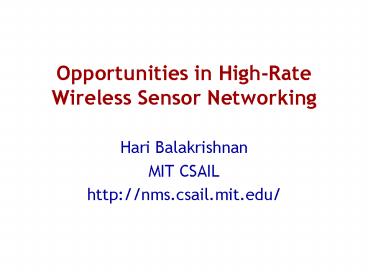Opportunities in High-Rate Wireless Sensor Networking - PowerPoint PPT Presentation
Title:
Opportunities in High-Rate Wireless Sensor Networking
Description:
Wireless Sensor Networking Hari ... degrades channel quality MAC protocols are too local to resolve ... at network layer Wireless networks do not have such shielding ... – PowerPoint PPT presentation
Number of Views:81
Avg rating:3.0/5.0
Title: Opportunities in High-Rate Wireless Sensor Networking
1
Opportunities in High-Rate Wireless Sensor
Networking
- Hari Balakrishnan
- MIT CSAIL
- http//nms.csail.mit.edu/
2
Todays WSN Monitoring Applications
- Periodic monitoring
- repeat
- wake up and sense
- transmit data
- sleep for minutes
- Event-based monitoring
- Transmit data on external event
- Low data rates duty cycles
Pic Sam Madden
Pic Sam Madden
3
High-Rate WSN Applications
- High sensing rates O(102 105) Hz
- Non-trivial analysis of gathered data
- Frequency analysis, correlation analysis
- Many domains
- Industrial monitoring, civil infrastructure,
medical diagnosis, process control, - What are the reusable components of a general
architecture for high-rate WSNs?
4
Industrial Monitoring
- Preventive maintenance of fabrication plant
equipment (Intel) - Done manually today, offline processing
- Sense vibration (acceleration)
- 100 machines, gt10 observation points per machine
- 10-40 kHz frequency band
- Aggregate data rate about 10 100 Mbits/s
Pic Wei Hong
5
Intel Fabs 20 Questions
- Is energy in f1, f2 gt E?
- Compare energy in f1, f2 with past activity
- Which frequency bands have highest energy?
- What is the phase relationship between samples at
different locations - Provide high-resolution view of last T mins of
samples at location L
6
Pipeline Pressure Monitoring
- Preventive maintenance of (aging) water and
sewage infrastructure - Leaks are precursors to bursts
- Monitor pressure and flow at 0.5 to 2 KHz
- Done manually today
Pic Rory OConnor (MIT)
7
Thames Waters 20 Questions(Thanks to Kevin
Amaratunga Ivan Stoianov)
- Whats the flow / pressure at location L?
- Is pressure / flow at location L different from
dynamic state estimator? - Has there been a significant pressure drop
between locations L1 and L2? - How long does it take pressure wave to travel
from L1 to L2?
8
Constraints
- Wireless communication rates
- Total required raw data rates exceed
next-generation radio rates - Energy
- Sensing and communication consume energy
- Want months of operation on batteries
- Unreliable sensor nodes
- In-the-net processing essential
9
Challenges
- High-level programming abstractions
- Distributed signal and data processing operators
- Collaborative data acquisition
- High-performance network delivery
10
High-Level Programming
- Users wont (cant) write embedded signal and
data processing code - Generalized stream processing continuous query
processing signal processing - Develop a declarative stream processing interface
- Support iterative refinement
11
Generalized Stream Processing
- Application-independent
- Continuous query processing (TinyDB)
- Distributing wavelet, Fourier operators
- Boxes and arrows program specification
- Connect up processing operators
- Specify high-level sampling rate
- Specify energy/lifetime constraints
- Support iterative refinement
12
Supporting Iterative Refinement
13
Collaborative Data Sampling
- Sampling rates too high for single sensors
- Sensing may not be fast enough, or
- Consumes too much energy
- Group of sensors subsample, collaboratively
produce desired sampling rate - Spreads processing and energy burden
- How should sub-sampled signals be aligned?
14
High-performance Data Delivery
- WSNs today have per-node delivery rates that are
10x worse than they should be - Obtain 5-10x improvement in throughput
distribution without physical layer changes - Traditional stack layers considered harmful
- Physical, linkMAC, network layer decomposition
bad for wireless
15
Traditional Layering has Problems
- With wires, links are shielded from one another
- Sharing starts only at network layer
- Wireless networks do not have such shielding
- No links over the air
- Increasing traffic degrades channel quality
- MAC protocols are too local to resolve contention
correctly
16
Dismal Throughput Distribution
HJB, Sensys04
17
A Different Layering May Help
- Replace current linkMAC and network layer
decomposition - Local channel control layer
- Traffic-based rate control, no per-packet
contention resolution - Has info about other nodes in region
- Take advantage of path diversity
- Global topology control layer
- Large-scale routing
18
Summary
- Many WSN applications require high sampling rates
- Want general distributed in-the-net processing
primitives - High-performance wireless data delivery with
different layered decomposition































